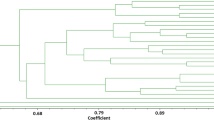Abstract
Since 1958 a search has been made for male sterile plants in fodder and sugar beet of West European origin. In some productive fodder beet varieties 11 male sterile plants were found in approx. 90,000 plants (0.01%), and in sugar beet varieties 32 in approx. 110,000 plants (0.03%).
The conclusion may be that male sterility occurs more in sugar beet than in fodder beet, although it may also be explained by a different descent.
Samenvatting
Sedert 1958 is een onderzoek gaande naar het voorkomen van mannelijke steriliteit bij Westeuropese voeder- en suikerbietenrassen. Bij enkele productieve voederbietenrassen werden op ±90.000 planten 11 mannelijk steriele planten (0,01%) gevonden en bij de suikerbieten-rassen op de ±110.000 32 mannelijk steriele planten (0,03%). Hieruit is af te leiden, dat mannelijke steriliteit meer bij suikerbieten voorkomt dan bij voederbieten. Dit kan het gevolg zijn van verschil in afstamming.
Similar content being viewed by others
References
Owen, F. V., Cytoplasmically inherited male sterility in sugar beets. Journal of Agricultural Research 71 (1945): 423–440.
Owen, F. V., Mendelian male sterility in sugar beets. Proceedings American Society of Sugar Beet Technologists (1952): 371–376.
Author information
Authors and Affiliations
Rights and permissions
About this article
Cite this article
Kloen, D. On the occurrence of male sterility in West-European fodder and sugar beets. Euphytica 13, 268–272 (1964). https://doi.org/10.1007/BF00023107
Received:
Issue Date:
DOI: https://doi.org/10.1007/BF00023107




